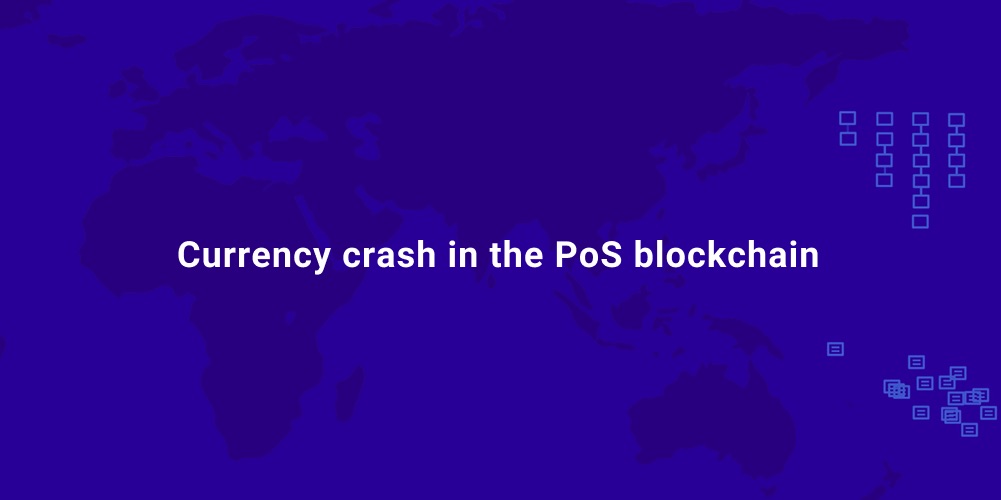Let's learn about Proof Of Work via these 55 free stories. They are ordered by most time reading created on HackerNoon. Visit the /Learn Repo to find the most read stories about any technology.
1. Why Selfish Mining is Detrimental to a Blockchain Network
 Selfish mining is a scenario where a miner mines a new block but fails to publish it for other miners to see and add it to the chain of blocks on their ends.
Selfish mining is a scenario where a miner mines a new block but fails to publish it for other miners to see and add it to the chain of blocks on their ends.
2. Ethereum's Deflationary Impact: What Investors Need to Know
 What exactly does becoming a deflationary cryptocurrency mean for Ethereum? And why is this important?
What exactly does becoming a deflationary cryptocurrency mean for Ethereum? And why is this important?
3. The Future of PoW Mining After The ETH 2.0 Merge: An Overview
 Bitcoin will most likely continue to use PoW. Post ETH 2.0, there is elevated risk of a much lower profitability for current ETH miners going forward.
Bitcoin will most likely continue to use PoW. Post ETH 2.0, there is elevated risk of a much lower profitability for current ETH miners going forward.
4. The Pros And Cons Of Proof Of Stake Technology
 There is no doubt that proof of stake (PoS) has become a popular consensus algorithm in the cryptocurrency world.
There is no doubt that proof of stake (PoS) has become a popular consensus algorithm in the cryptocurrency world.
5. ETH-flexive
 Either the merge happens, or it doesn’t. That is the future event we are trading. The merge itself is unaffected by the price of ETH
Either the merge happens, or it doesn’t. That is the future event we are trading. The merge itself is unaffected by the price of ETH
6. My 5 Favorite Proof of Work Cryptocurrencies
 Proof of Work is an important aspect of the cryptocurrency solution. Here are my favorite Proof of Work cryptocurrencies.
Proof of Work is an important aspect of the cryptocurrency solution. Here are my favorite Proof of Work cryptocurrencies.
7. Why Proof-of-work Will Always be an Essential Part of Ethereum
 Justin Sun highlights why proof-of-work is an essential part of Ethereum, and lends his expert insights regarding the matter.
Justin Sun highlights why proof-of-work is an essential part of Ethereum, and lends his expert insights regarding the matter.
8. Bitcoin White Paper: 4. Proof-of-Work
 To implement a distributed timestamp server on a peer-to-peer basis, we will need to use a proof-of-work system similar to Adam Back's Hash cash [6], rather than newspaper or Usenet posts. The proof-of-work involves scanning for a value that when hashed, such as with SHA-256, the hash begins with a number of zero bits. The average work required is exponential in the number of zero bits required and can be verified by executing a single hash.
To implement a distributed timestamp server on a peer-to-peer basis, we will need to use a proof-of-work system similar to Adam Back's Hash cash [6], rather than newspaper or Usenet posts. The proof-of-work involves scanning for a value that when hashed, such as with SHA-256, the hash begins with a number of zero bits. The average work required is exponential in the number of zero bits required and can be verified by executing a single hash.
9. Proof of Work is the Solution Not a Problem
 Proof of Work is the most secure Internet protocol ever created
Proof of Work is the most secure Internet protocol ever created
10. Proof of Work is a Tried and True Solution
 Gold is the original Proof of Work to back a currency.
Gold is the original Proof of Work to back a currency.
11. What is up with ETC in Context of the Imminent ETH's "The Merge"
 An analysis on what may happen to the price of ETC in the context of upcoming the Merge of ETH moving from PoW to PoS
An analysis on what may happen to the price of ETC in the context of upcoming the Merge of ETH moving from PoW to PoS
12. Coming to Consensus: Proof-of-Work vs Proof-of-Stake
 An article that both explains and compares Proof-of-Work (used by Bitcoin and Ethereum) and Proof-of-Stake (used by many other blockchains)
An article that both explains and compares Proof-of-Work (used by Bitcoin and Ethereum) and Proof-of-Stake (used by many other blockchains)
13. Proof of Stake is an Old Solution
 To call Proof of Stake a savior is a stretch. To call Proof a Stake a stopgap…perhaps. To call Proof of Stake something new is simply not true.
To call Proof of Stake a savior is a stretch. To call Proof a Stake a stopgap…perhaps. To call Proof of Stake something new is simply not true.
14. What is the Difference Between Miner Extractable Value and Maximal Extractable Value
 Miner extractable value vs Maximal extractable value
Miner extractable value vs Maximal extractable value
15. What Ethereum's Move To Proof Of Stake Means
 Two common PoS implementations are BFT and Ouroboros. Blockchains turn to PoS due to factions such as TPS, decentralization, tokenomics, and fast finality.
Two common PoS implementations are BFT and Ouroboros. Blockchains turn to PoS due to factions such as TPS, decentralization, tokenomics, and fast finality.
16. Algorand and the Blockchain Trilemma
 Through a more clever mix of game theory and cryptography, Silvio Micali and his team might have created tomorrow’s infrastructure. Fast, secure and scalable.
Through a more clever mix of game theory and cryptography, Silvio Micali and his team might have created tomorrow’s infrastructure. Fast, secure and scalable.
17. One Hour of "Effective" Freelance Work is Worth 3 Hours in a 9-5 Job
 One effective freelance working hour is worth two or three regular 9-to-5 working hours.
One effective freelance working hour is worth two or three regular 9-to-5 working hours.
18. Carbon Footprint: Proof-of-Work vs. Proof-of-Stake
 Many tech experts argue about Blockchain's carbon footprints consensus mechanisms. Learn the pros and cons of proof-of-stake vs. proof-of-work.
Many tech experts argue about Blockchain's carbon footprints consensus mechanisms. Learn the pros and cons of proof-of-stake vs. proof-of-work.
19. Web3 is not About Blockchain or Decentralization
 Web3 is not about blockchain or decentralization. It is about the democratization of the web
Web3 is not about blockchain or decentralization. It is about the democratization of the web
20. How Cosmos Proof-Of-Stake Helps Create a More Sustainable Blockchain Environment
 At the heart of the mission was the need to address the throughput, scalability, and importantly, environmental issues associated with Proof of Work blockchain.
At the heart of the mission was the need to address the throughput, scalability, and importantly, environmental issues associated with Proof of Work blockchain.
21. 10 Shared Beliefs of a Bitcoin Maximalist
 While some maximalists assert that altcoins are just unregistered securities, most consider them technically and morally questionable, if not outright scams.
While some maximalists assert that altcoins are just unregistered securities, most consider them technically and morally questionable, if not outright scams.
22. 51% Attacks Pose the Biggest Threat to Smaller Mining-Based Cryptocurrencies
 A 51% attack is where an actor controlled over half of the mining power in order to reverse transactions and compromise the security of the network.
A 51% attack is where an actor controlled over half of the mining power in order to reverse transactions and compromise the security of the network.
23. Reducing The Environmental Impact of NFTs and Proof-Of-Work
 Why are NFTs bad for the environment? These are all examples built on blockchains that do not use Proof-of-Work or any other type of energy-intensive methods.
Why are NFTs bad for the environment? These are all examples built on blockchains that do not use Proof-of-Work or any other type of energy-intensive methods.
24. The Proof of Stake Trojan Horse
 The Proof of Stake versus Proof of Work debate will affect how cryptocurrencies move forward.
The Proof of Stake versus Proof of Work debate will affect how cryptocurrencies move forward.
25. Ethereum Enters New Phase of Adoption
 Prices of ETH have gone bearish following the Merge's successful execution, which upgraded the Ethereum network from PoW to PoS in September.
Prices of ETH have gone bearish following the Merge's successful execution, which upgraded the Ethereum network from PoW to PoS in September.
26. What You Need to Know About Bitcoin's Energy Usage
 Learn the truth about Bitcoin’s energy consumption and understand why its environmental impact isn’t as bad you think.
Learn the truth about Bitcoin’s energy consumption and understand why its environmental impact isn’t as bad you think.
27. What Is Hashing in Blockchain: A Beginner-Friendly Guide
 The implementation of a cryptographic hash function is beneficial to prevent fraudulent transactions, double spends in blockchain, and store passwords.
The implementation of a cryptographic hash function is beneficial to prevent fraudulent transactions, double spends in blockchain, and store passwords.
28. The Approach and the Solution to the Blockchain Trilemma
 Kaspa has made the blockchain trilemma a thing of the past with it's approach and the solution to the blockchain trilemma... and it's an actual solution.
Kaspa has made the blockchain trilemma a thing of the past with it's approach and the solution to the blockchain trilemma... and it's an actual solution.
29. Perils of Induction: Doubting Thomases, Rigor, NFTs & Descartes

30. Proof-of-Stake vs Proof-of-Work vs Proof-of-Time: What’s the Difference?
 We'll look at the difference between these three algorithms - Proof-of-Stake vs Proof-of-Work vs Proof-of-Time and how they compare.
We'll look at the difference between these three algorithms - Proof-of-Stake vs Proof-of-Work vs Proof-of-Time and how they compare.
31. The Next Evolution in Consensus: Proof of Burn!
 Koinos Group reveals the next generation of consensus algorithms with greater decentralization that proof-of-work, and greater efficiency than proof-of-stake.
Koinos Group reveals the next generation of consensus algorithms with greater decentralization that proof-of-work, and greater efficiency than proof-of-stake.
32. Resisting Plutocracies In The World of Blockchain And Web3
 Finding a human-centric solution to the problems that most blockchains face when it comes to fair voting in its currently plutocratic and unequal form.
Finding a human-centric solution to the problems that most blockchains face when it comes to fair voting in its currently plutocratic and unequal form.
33. The Art & Science of Node Monitoring
 One of the hardest parts of designing a monitoring system is predicting everything that “might” go wrong. That only comes from experience, not just over time, b
One of the hardest parts of designing a monitoring system is predicting everything that “might” go wrong. That only comes from experience, not just over time, b
34. What is 'Sharding' and UTXO Scaling for Blockchain?
 We propose an improved algorithm called proof-of-less-work.
We propose an improved algorithm called proof-of-less-work.
35. Differences Between Proof of Work and Proof of Stake Network When Buying Ethereum
 Since the recent launch of Ethereum's new network called proof of stake, there have been multiple questions on how it differentiates from the already existing proof of work mining network and how it will affect people that buy Ethereum. It has become a major concern among investors, traders, cryptocurrency enthusiasts, and those who buy Ethereum.
Since the recent launch of Ethereum's new network called proof of stake, there have been multiple questions on how it differentiates from the already existing proof of work mining network and how it will affect people that buy Ethereum. It has become a major concern among investors, traders, cryptocurrency enthusiasts, and those who buy Ethereum.
36. Proof of Stake vs Proof of Work: The Case of Transaction Finality
 In this article, we look at the two most popular consensus mechanisms - PoW and PoS - and show why PoW stands out in terms of transaction finality.
In this article, we look at the two most popular consensus mechanisms - PoW and PoS - and show why PoW stands out in terms of transaction finality.
37. Undying Mining Dispute: Be PoW-conformist or Try Alternatives?
 While traditional blockchains focus their rewarding on transaction processing, Proof-of-Data-chains are focused on data stored in decentralized filesystem.
While traditional blockchains focus their rewarding on transaction processing, Proof-of-Data-chains are focused on data stored in decentralized filesystem.
38. Proof of Work (PoW) vs. Proof of Stake (PoS): Sharding Edition
 The blockchain scalability problem is currently the main limitation for the mass adoption of blockchain technology. In the standard permissionless p2p blockchain design introduced by Satoshi Nakamoto, every node has to process all the data in the network.
The blockchain scalability problem is currently the main limitation for the mass adoption of blockchain technology. In the standard permissionless p2p blockchain design introduced by Satoshi Nakamoto, every node has to process all the data in the network.
39. The Ethereum Merge, Explained
 Ethereum emits nearly the same amount of carbon dioxide as Singapore at this time and is the second-largest blockchain, after only bitcoin. If the Merge is successful, it will significantly reduce ethereum’s high electricity usage by almost 99%.Key Highlights
Ethereum emits nearly the same amount of carbon dioxide as Singapore at this time and is the second-largest blockchain, after only bitcoin. If the Merge is successful, it will significantly reduce ethereum’s high electricity usage by almost 99%.Key Highlights
40. Layer 1 vs Layer 2: Where’s the Next Block Party At?
 Layer 1 versus Layer 2 blockchain solutions. Layer 2 blockchain protocols have posted stellar performance in 2021. So what are they to a layer 1 solution?
Layer 1 versus Layer 2 blockchain solutions. Layer 2 blockchain protocols have posted stellar performance in 2021. So what are they to a layer 1 solution?
41. The Essential Guide to Proof of Work (PoW) in Blockchain
 Proof of Work (commonly abbreviated to PoW) is a consensus algorithm used for preventing the 51% attack or double-spends.
Proof of Work (commonly abbreviated to PoW) is a consensus algorithm used for preventing the 51% attack or double-spends.
42. Is There a Security Vs. Coin Creation Trade-Off in Blockchains?
 Recent years have sparked significant interest in blockchain networks. This has resulted in significant progress in the theory of such distributed networks. In particular, followers gathered more data about possible blockchain designs, their limitations, and their trade-offs. There's called The trade-off between security and coin creation
Recent years have sparked significant interest in blockchain networks. This has resulted in significant progress in the theory of such distributed networks. In particular, followers gathered more data about possible blockchain designs, their limitations, and their trade-offs. There's called The trade-off between security and coin creation
43. Of Blockchain Technology, Sustainability, and Applicability
 INTRODUCTIONThe blockchain technology and the opportunities it created began to enter our lives about 10 years ago. The technology that we are most familiar with is Bitcoin, a cryptocurrency that uses the blockchain technology. After the invention of Bitcoin many other cryptocurrencies have followed suit. Bitcoin is still at the top and was the first to introduce the Proof of Work algorithm, which we'll talk about in a moment, however, this system is now quite outdated. In this article we are going to discuss the technical aspects of the Blockchain technology, Bitcoin and the algorithms it uses and applications for the Blockchain technology.
INTRODUCTIONThe blockchain technology and the opportunities it created began to enter our lives about 10 years ago. The technology that we are most familiar with is Bitcoin, a cryptocurrency that uses the blockchain technology. After the invention of Bitcoin many other cryptocurrencies have followed suit. Bitcoin is still at the top and was the first to introduce the Proof of Work algorithm, which we'll talk about in a moment, however, this system is now quite outdated. In this article we are going to discuss the technical aspects of the Blockchain technology, Bitcoin and the algorithms it uses and applications for the Blockchain technology.
44. Rising Gas Fees in the Run-up to Ethereum 2.0 Upgrade
 Ethereum gas fees have been on the rise since the beginning of the year. In the latest developments, miners on the world’s second-largest blockchain protocol voted to increase the gas limit from 10 to 12.5 million Gwei. This increase of 25 percent in miner fees contributes to the more than 75 percent rise year-to-date.
Ethereum gas fees have been on the rise since the beginning of the year. In the latest developments, miners on the world’s second-largest blockchain protocol voted to increase the gas limit from 10 to 12.5 million Gwei. This increase of 25 percent in miner fees contributes to the more than 75 percent rise year-to-date.
45. Proof of Work vs. Proof of Stake: How Different Are They Really?
 Proof of work and proof of stake are the two most popular transaction validation methods on blockchains. Both have compelling arguments as to why they are more efficient, cheaper, more scalable or more secure, so let’s tackle what makes each different and why it matters.
Proof of work and proof of stake are the two most popular transaction validation methods on blockchains. Both have compelling arguments as to why they are more efficient, cheaper, more scalable or more secure, so let’s tackle what makes each different and why it matters.
46. Is Proof-of-Stake the Future of Consensus? Blockscale Doesn’t Think So!
 Intel's new pro-mining ASIC chipset—Blockscale—isn't just efficient. It has the future of crypto adoption in mind and Intel is in the space for the long haul.
Intel's new pro-mining ASIC chipset—Blockscale—isn't just efficient. It has the future of crypto adoption in mind and Intel is in the space for the long haul.
47. The Origins of Proof-of-Less-Work and More
 A Founder interview with Cheng Wang, founder of Alephium and creator of Proof-of-Less-Work, an alternative third road in the world of blockchain staking
A Founder interview with Cheng Wang, founder of Alephium and creator of Proof-of-Less-Work, an alternative third road in the world of blockchain staking
48. PoW-Based NFTs in 2021: A Comparison
 There are three currently known PoW based NFTs for readers to compare and consider which would be the next hotspot and opportunity in the NFT market.
There are three currently known PoW based NFTs for readers to compare and consider which would be the next hotspot and opportunity in the NFT market.
49. Crypto Energy Consumption: Clean & Green Could Be the Solution
 For advocates of the widescale adoption of cryptocurrency, there is one major challenge that stands in the way of their dream coming true. Namely, the fact that mining cryptocurrencies require exorbitant — and seemingly wasteful — amounts of energy.
For advocates of the widescale adoption of cryptocurrency, there is one major challenge that stands in the way of their dream coming true. Namely, the fact that mining cryptocurrencies require exorbitant — and seemingly wasteful — amounts of energy.
50. Looking Into Ethereum’s Merge And How KIRA Circumvents PoS’s Biggest Weakness
 Ethereum's Merge switched the blockchain from Proof of Work to Proof of Stake. While it addressed some of the old problems, it created a new set to deal with.
Ethereum's Merge switched the blockchain from Proof of Work to Proof of Stake. While it addressed some of the old problems, it created a new set to deal with.
51. Halving Is No Longer Magic, but Not Yet a Messiah
 Halving is an event when the amount of payment for cryptocurrency mining is halved compared to what it was before.
Halving is an event when the amount of payment for cryptocurrency mining is halved compared to what it was before.
52. Why PoW NFTs are the Next Blue-Chip NFT Collections
 PoW NFTs are still under the radar and this article will guide you through learning about PoW NFTs and understanding the values.
PoW NFTs are still under the radar and this article will guide you through learning about PoW NFTs and understanding the values.
53. A Technical Q&A on Network Partition Attacks
 Cryptocurrencies are prone to many different types of attack. As Bitcoin is over 11 years on the track, we know and were facing many different attempts on breaking its security. One of them is network partition attack.
Cryptocurrencies are prone to many different types of attack. As Bitcoin is over 11 years on the track, we know and were facing many different attempts on breaking its security. One of them is network partition attack.
But what about the Proof-of-Stake algorithms? Have they solved some of the vulnerabilities of Bitcoin and its Proof-of-Work algorithm?
54. Learn the blockchain basics - Part 2 : "Mining", "Miners", and the Proof of Work Algorithm
 The second episode of this series describes the Proof of Work algorithm.
After reading this article, you should have a basic understanding of the PoW algorithm.
The second episode of this series describes the Proof of Work algorithm.
After reading this article, you should have a basic understanding of the PoW algorithm.
55. Code A Full Node for A Proof Of Work Blockchain - From Scratch
 Learn the basics of PoW Blockchain and create your own Coin
Learn the basics of PoW Blockchain and create your own Coin
Thank you for checking out the 55 most read stories about Proof Of Work on HackerNoon.
Visit the /Learn Repo to find the most read stories about any technology.

